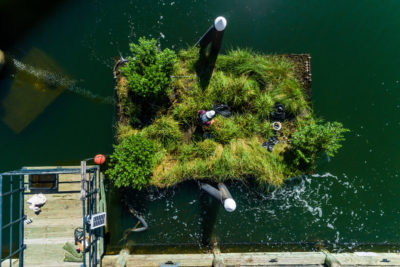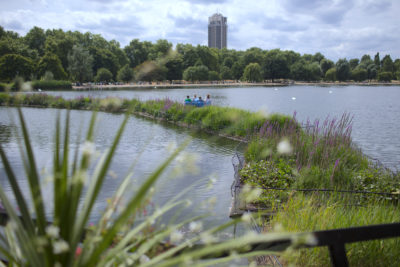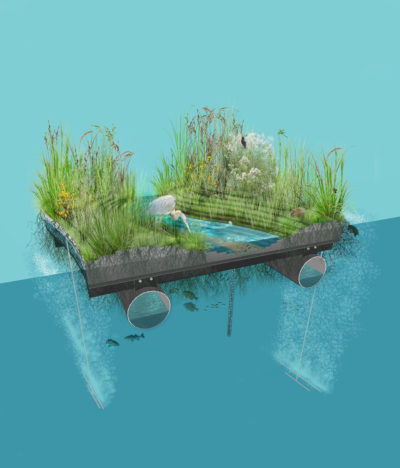by Susan Cosier: Five small islands roughly the size of backyard swimming pools float next to the concrete riverbank of Bubbly Creek,
 a stretch of the Chicago River named for the gas that once rose to the surface after stockyards dumped animal waste and byproducts into the waterway. Clumps of short, native grasses and plants, including sedges, swamp milkweed, and queen of the prairie, rise from a gravel-like material spread across each artificial island’s surface. A few rectangles cut from their middles hold bottomless baskets, structures that will, project designers hope, provide an attachment surface for freshwater mussels that once flourished in the river.
a stretch of the Chicago River named for the gas that once rose to the surface after stockyards dumped animal waste and byproducts into the waterway. Clumps of short, native grasses and plants, including sedges, swamp milkweed, and queen of the prairie, rise from a gravel-like material spread across each artificial island’s surface. A few rectangles cut from their middles hold bottomless baskets, structures that will, project designers hope, provide an attachment surface for freshwater mussels that once flourished in the river.
Three thousand square feet in total, these artificial wetlands are part of an effort to clean up a portion of a river that has long served the interests of industry. This floating wetland project is one of many proliferating around the world as cities increasingly look to green infrastructure to address toxic legacies. In the United States, researchers are conducting experiments in Boston and Baltimore as well as in Chicago, each team sharing best practices with the other to maximize the ecological benefits of their systems. The Canadian government and local municipalities are allotting more funding for innovative projects. Floating wetlands are also multiplying in the United Kingdom, and studies to quantify additional benefits continue in Australia and Brazil.
Floating wetlands filter contaminants and take up excess agricultural nutrients that can lead to algal blooms and dead zones.
Like natural wetlands, floating versions provide a range of ecosystem services. They filter sediment and contaminants from stormwater, and laboratory experiments show that some plants have the ability to lock up some chemicals and metals found in acid mine drainage. These systems take up excess agricultural nutrients that can lead to algal blooms and dead zones, and recent research suggests they could be used to reduce manmade contaminants that persist in the environment. Though it’s difficult to quantify the exact benefits these systems offer, and they have limitations as a tool in remediating polluted waterways, they could provide another option, researchers say.
Nick Wesley, executive director of Urban Rivers, a nonprofit working with the Shedd Aquarium on the Chicago project, believes floating systems are a natural fit for the urban environment. Many urbanized river systems, he says, have the same “steel sheet pile wall, some rough-wrap riprap on the edges. We’re trying to [restore] what the naturalized river would be.” In many cities, he continues, floating wetlands could provide a low-cost alternative to conventional infrastructure projects because they’re modular and easy to install and to monitor.
Wesley’s group began, in 2018, with a floating wetlands project on the Chicago River’s North Branch. Called the Wild Mile, the installation aims to improve water quality and has already begun attracting invertebrates, including mollusks and crustaceans. Last month, the group expanded to the shores of Bubbly Creek. Urban Rivers, Shedd employees, and a team of volunteers bolted together polyethylene and metal frames, draped them with matting, dropped them in the water, added plants, and anchored the islands to the river bottom so they stay in place as the roots grow into the water. The plants will grow for years to come, part of a “riverponic” system, as Wesley calls it, that requires no soil or other substrate for support.
A floating wetland in Baltimore’s Inner Harbor installed by the National Aquarium. NATIONAL AQUARIUM
Floating wetlands “are having a bit of a moment,” says Richard Grosshans, a research scientist with the International Institute for Sustainable Development who works on the floating structures. “They function very similarly to a natural wetland: they have the same processes, plants and microorganisms, bacteria and algae, [which] naturally break down toxins. They take up nutrients and provide habitat. It’s kind of common sense to those of us who work with these types of systems.”
Floating wetlands were first tested in retention ponds, the kind often located near developments to hold stormwater, to see if they filtered pollution. “The front end of it was, ‘Will they work? How well do they work? And what plants should we recommend?’” says Sarah White, an environmental toxicologist and horticulturalist at Clemson University who has worked on floating wetlands since 2006. Partnering with researchers at Virginia Tech, White found that the wetland plants she tested not only did well in ponds with lots of nutrient pollution, but the adaptable, resilient plants actually thrived. She did not always choose native plants, opting instead for those that would make the islands more attractive, so that more urban planners would use them.
In the early 2010s, Chris Walker, a researcher at the University of South Australia, began testing floating wetlands in wastewater, quantifying the pollutants that four species of plants took up in their tissues and improvements to water quality. Two species, twig rush Baumea articulata and the common reed Phragmites australis, showed the highest uptake of nitrogen and phosphorus of any floating wetland research to date. “That creates a real opportunity for [the] permanent removal of sequestered nutrients,” says Walker, who is also the principal scientist for a floating wetland company called Clarity Aquatic.
One acre of floating wetland can absorb the nutrient pollution from seven to 15 acres of urban development, one researcher found.
His team also started testing the ability of floating wetlands to filter out emerging contaminants like per- and polyfluoroalkyl substances (PFAS), which are not always filtered by treatment plants and are linked to elevated cholesterol levels, problems with reproductive health, and kidney and testicular cancers. The reed Phragmites australis placed in a floating wetland began absorbing the pollutant into its tissues in less than a month.
Islands anchored in cities are giving scientists an opportunity to study environments that have long been ignored. In Chicago, Austin Happel, a research biologist at the Shedd Aquarium, is beginning a study on fish near the floating wetlands in Bubbly Creek. Starting in the spring, he’ll use acoustic telemetry to tag fish captured near the wetland and monitor where they go. By the following year, he should be able to see if they use the floating wetlands as a buffet or as a place to hide from predators.
In Boston, Max Rome, a PhD student at Northeastern University, is attempting to quantify the benefits of wetlands that have been floating since 2020 in the Charles River, another historically degraded waterway. He found that one acre of wetland can absorb the nutrient pollution — usually dumped into the river via stormwater — from seven to 15 acres of dense urban development.
Rome is also looking into whether floating wetlands can create small pockets of improved water quality or habitat that allow certain native species, like freshwater sponges, to regain a toehold in the river. To do that, he monitored water quality near the wetlands and compared it to other places in the river.
“The last generation did a really good job of dealing with point source pollution — and it was a huge task,” he says, referring to the success of the Clean Water Act in reducing effluent from discharge pipes. His generation has a new job, he adds: grappling with “ecological restoration of these degraded water bodies at the same time that we do pollution reduction,” something the wetlands could help address.
Despite the benefits of floating wetlands, obstacles to widespread adoption remain. They require time and energy to install and monitor, and they could potentially cause flooding if they become unmoored and interfere with water flow. A city would also need hundreds of floating wetlands to clean up the most polluted stretches of waterways and manage the contaminants that continue to flow into them.
Another potential drawback is the threat of invasive plants colonizing a floating wetland, which would then require maintenance. One species that effectively sucked up PFAS in the Australian study, for example, is an aggressive invader already colonizing wetlands across the U.S. In addition, if the goal of a floating wetland is to permanently remove phosphorous and nitrogen from an ecosystem, managers may need to remove and compost plants so they don’t release the nutrients back into the environment when they go dormant, though ongoing research suggests that biofilms that form on plant roots and on the bottom of wetlands could continue to remove nutrients even after plants start to senesce. Plants that remove PFAS would likely need to be incinerated.
The National Aquarium in Baltimore is planning to expand its 400-square-foot floating wetland to 10,000 square feet by 2024.
Still, say researchers, floating wetlands do benefit the environment. “I think we’re just looking for one more tool in our toolbox to help manage water quality,” says Clemson’s White. “This gives us another place in the landscape where we can actually have a technology that will do it.”
The types of places that could be improved by these projects are growing more varied. The National Aquarium in Baltimore was the first place in the U.S. to test floating wetlands in a tidal system, and today 400 square feet planted in saltmeadow hay and smooth cordgrass float in the city’s Inner Harbor. The project has been so successful at lowering levels of nutrients and bacteria and at creating a refuge for wildlife — including American eels, gizzard shad, and ghost anemones — that the aquarium now plans to expand the islands to 10,000 square feet in 2024, says Charmaine Dahlenburg, the aquarium’s director of field conservation.
The Harbor islands are the National Aquarium’s fourth attempt at creating a thriving wetland system, demonstrating how difficult it can be to tailor a floating wetland to a specific location. When the aquarium first installed wetlands in 2010, geese invaded them and ate the plants. A similar problem occurred with a second version two years later. The third attempt fared better, thanks to fencing that excluded geese, but the fourth iteration — which incorporates a channel that prevents algal blooms from killing plants — fared the best.
National Aquarium researchers investigating how the floating wetlands help mitigate such blooms found that microscopic organisms on plant roots and on the bottom of the wetlands help move nitrogen from the water and through the food chain — from barnacle to crab to fish. There are ecosystem benefits above the waterline, too: Night herons and otters visit the islands, finding refuge in the grasses. Research on fish, birds, and mammals attracted to floating wetlands is not well developed, but these structures clearly provide habitat in places where buildings, bulkheads, and riprap have replaced natural wetlands.
The amount of contamination that plants can remove from aquatic environments depends on the amount and type of pollution, the plant species used, and the size of the floating wetlands. But some scientists, including Dahlenburg and Rome, are hoping that as research accumulates, government agencies will consider using such projects to mitigate contamination and wetland development.
In three Boston-area watersheds, a new regulation under the Clean Water Act will require certain commercial, industrial, and institutional properties with one or more acres of impervious surface to reduce nutrient and bacterial pollution in stormwater running off their properties, something never mandated before. Britain recently announced a requirement for homes and water companies to reduce water pollution. Floating wetlands that do that are already growing in London, and plans for other locations are in the works.
Regulations like these could compel cities to take a more aggressive approach to green stormwater infrastructure. “As that begins to happen,” says Rome, “the role that can be played by floating treatment wetlands is going to come into focus.”
The growing use of the buoyant, lush gardens — in cities that range from Australia to Europe to North America — show how even small wetland islands can make a difference. “Our little postage stamp of a wetland isn’t going to solve everything,” says Dahlenburg, of the Baltimore project. “What we’re trying to create is this model urban waterfront. We want other cities to know that there are ways to incorporate natural habitat, to bring back the ecosystem services that were lost because of industrial development.”












































